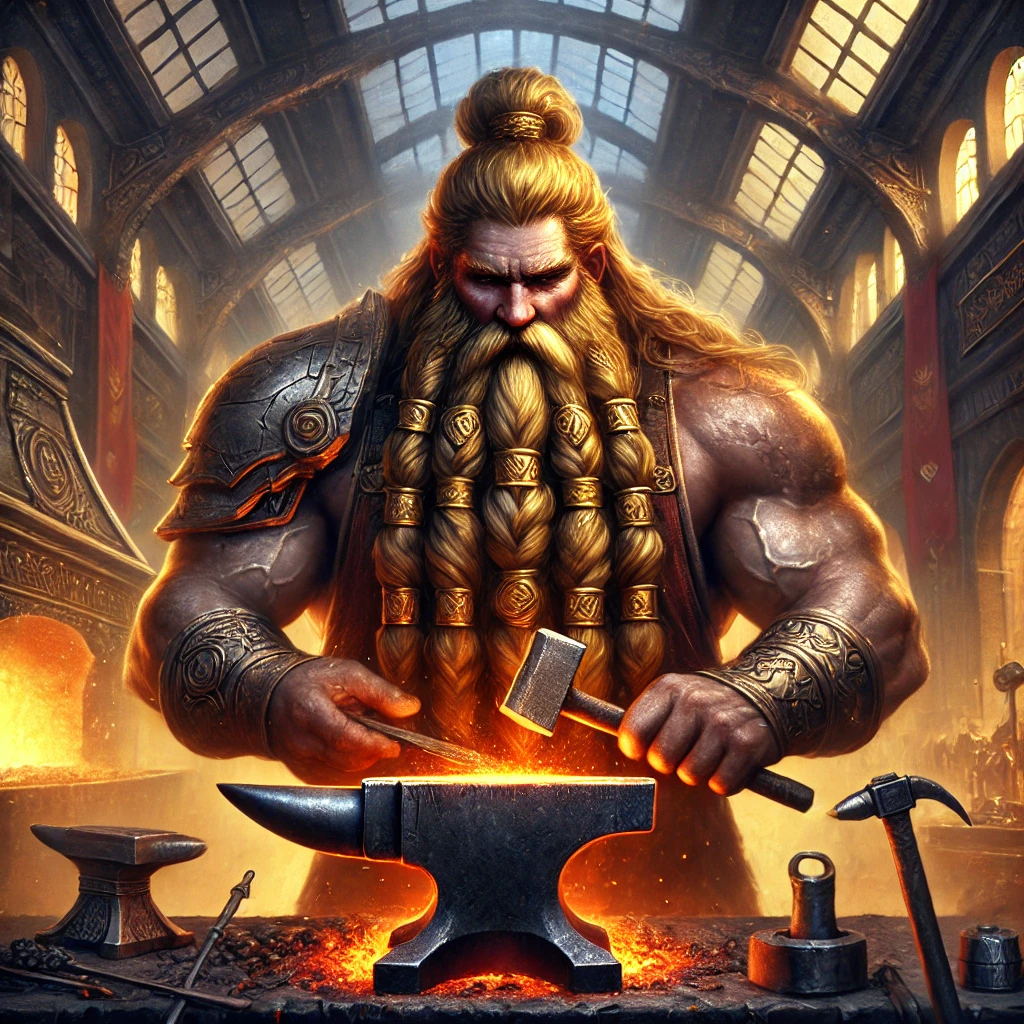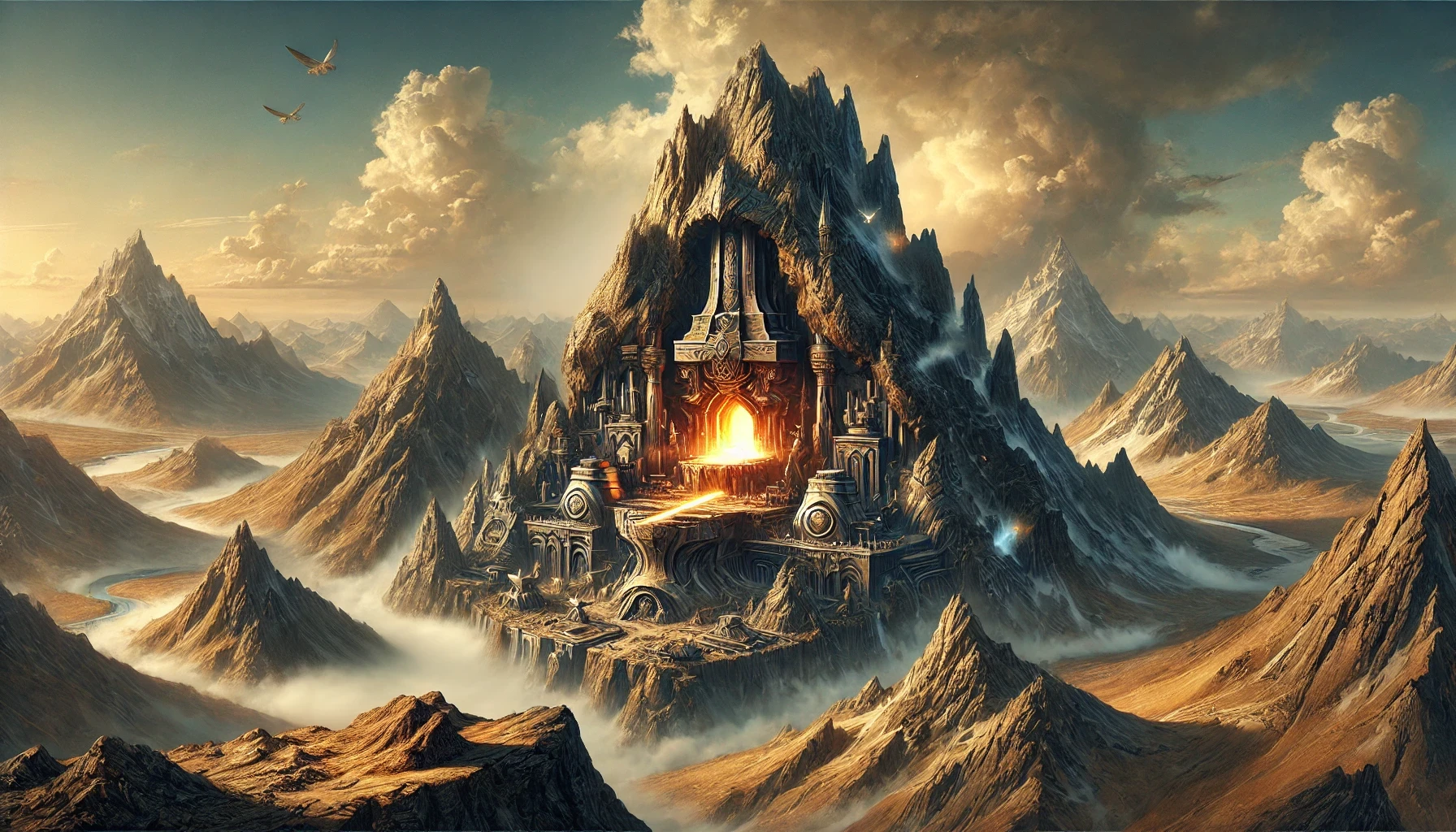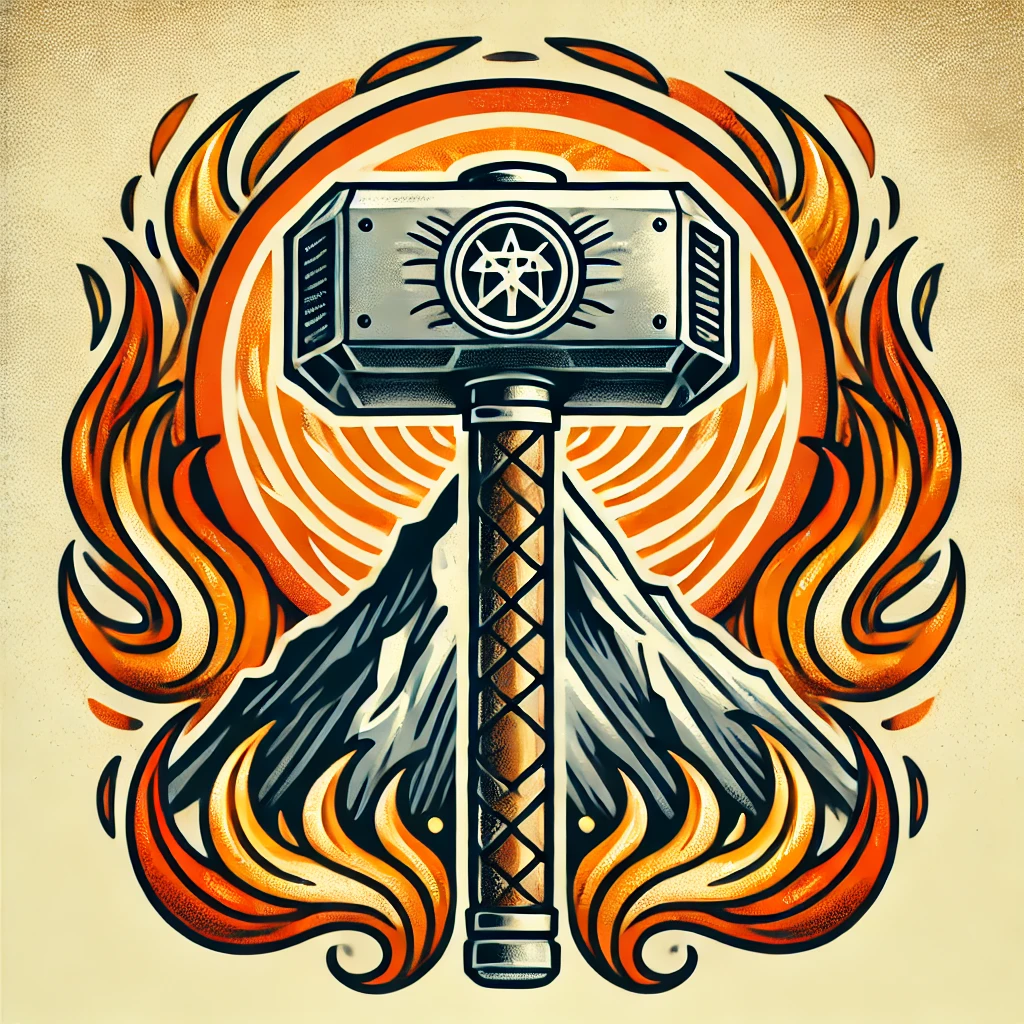Molgrin (MOHL-grin)
Earthshaker Molgrin (a.k.a. Forgefather)
While Molgrin is known as a forger of weapons and artifacts, his role extends far beyond the hammer and anvil. He is a god of progress and innovation, inspiring mortals to look beyond tradition and create something entirely new. He whispers to inventors, guides the hands of craftsmen, and stokes the fires of creativity in all who seek to build. His domain includes not only metal and stone but also the spark of invention that drives mortals to explore and push boundaries.
Molgrin is revered by all who work with their hands—blacksmiths, sculptors, inventors, and even engineers. His priests often double as artisans, teaching their communities new techniques or preserving ancient knowledge. His temples are filled not only with forges and anvils but also with libraries and workshops, where knowledge and craftsmanship are celebrated equally.
Divine Domains
- Forge (Creation and Craftsmanship)
- Fire (Passion and Transformation)
- Earth (Mountains and Foundations)
- Invention (Innovation and Progress)
- Destruction (Controlled Chaos)
- Community (Collaboration and Teaching)
- Knowledge (Practical Wisdom)
Artifacts
Runebreaker (Divine Hammer)
Runebreaker is Molgrin's personal hammer, a colossal tool of creation and destruction. Its head glows with molten fire, engraved with runes of power that shift and flicker like flames. The haft is crafted from unbreakable obsidian and adorned with golden inlays depicting mountains and flowing magma. Runebreaker is said to have forged the weapons of the gods, and no mortal has ever been able to lift it unaided.Ashenveil (Cloak of Smoke and Flame)
A fiery cloak woven from living flames and embers, Ashenveil constantly shifts in color from deep red to brilliant gold. Despite its fiery appearance, it never harms its wearer or allies. It Surrounds the wearer with an aura of fire that burns enemies and melts weapons that come too close. When activated, the cloak turns into a thick cloud of ash and smoke, providing concealment and disorienting foes and also, grants the wearer immunity to fire and allows them to walk through lava or flames unscathed. The cloak was forged from the first flames of Molgrin’s divine forge and gifted to his most loyal mortal champion.Heart of the Mountain (Amulet of Earth and Fire)
A gemstone the size of a fist, glowing with an inner flame, set into an unbreakable chain of molten gold. The Heart of the Mountain pulses faintly, as if alive. It grants the wearer immense strength, endurance, and resistance to damage. It also Summons eruptions of lava or rains molten rock upon enemies in times of great need and allows the wearer to commune with mountains, locate hidden veins of metal, or stabilize quaking ground. The Heart is said to contain a fragment of Molgrin’s essence, imbuing the wearer with his strength and ingenuity.Divine Symbols & Sigils
The Hammer and Mountain
A hammer crossed with a mountain peak, encircled by flames. The hammer represents Molgrin’s craftsmanship, while the mountain symbolizes his dominion over earth and metal. The flames encircling the design signify both the forge and the spark of creation. Sometimes depicted with glowing runes on the hammer or a molten core within the mountain to emphasize his creative power. This symbol is carved into forges, tools, and weapons as a mark of divine blessing. It is also worn as a pendant by his followers.The Molten Anvil
An anvil with molten metal flowing from its edges, surrounded by a halo of sparks. It represents the foundation of creation, progress, and the transformation of raw materials into something greater and is often engraved above temple forges or used as the centerpiece of altars in Molgrin’s worship.The Emberwheel
A circular gear or wheel, half made of stone and half aflame. It represents the balance between invention (the wheel) and nature’s raw power (fire). It signifies the union of progress and tradition. It is a favorite emblem of inventors and engineers, commonly incorporated into tools, blueprints, or banners.The Flaming Forge
A stylized forge with flames erupting from it, forming the shape of a rising sun. It symbolizes the dawn of new ideas and the transformative power of the forge. It is found in temples dedicated to innovation and progress, often as a stained-glass design or mural.Tenets of Faith
- Creation is Sacred To create is to honor Molgrin. Whether it is a tool, a weapon, a work of art, or an invention, the act of shaping something new is a prayer in itself. Every creation, no matter how small, contributes to the greater whole.
- Progress Through Perseverance Mastery is achieved through effort and repetition. Failure is not the end but a step on the path to improvement. The flame of progress burns brightest in those who endure and innovate.
- Respect the Earth’s Bounty The earth offers its treasures—metal, stone, and gems—but they must be used wisely. Waste and greed are affronts to Molgrin’s teachings. Treat raw materials with respect, as they are the foundation of creation.
- The Forge is Unity Collaboration strengthens creation. Just as molten metal is shaped by many tools, so too are communities shaped by their members. Share knowledge, teach others, and work together to achieve greatness.
- Invention is a Divine Calling Embrace curiosity and innovation. Seek to improve upon old designs, discover new techniques, and challenge the boundaries of possibility. Stagnation is the enemy of progress.
- Balance Destruction and Creation Fire can destroy as easily as it creates. Use its power wisely. Break only what must be broken, and build in its place something stronger and more enduring.
- Honor Your Craft Every craftsman’s work reflects their soul. Strive for excellence in all you do, and never let haste or carelessness mar your creations. A poorly made tool dishonors both its maker and Molgrin.
- Strength is in the Foundation Whether building a tool, a home, or a life, the foundation must be solid. Rushing to finish while neglecting the basics invites collapse. Take your time to build strong and true.
- Teach and Preserve Knowledge Pass down your skills, methods, and ideas. Each generation should build upon the last, ensuring that progress is not lost. Knowledge shared is knowledge immortalized.
- Fire is Life and Light Fire is the heart of the forge and the light that guides progress. Protect it, nurture it, and wield it with care. Let its warmth inspire you, but do not let it consume you.
Oaths for Priests and Devout Followers
- "By the flame of the forge, I swear to shape the world with my hands and heart."
- "I shall treat the earth’s gifts with respect and use them to build, not to waste."
- "I vow to preserve and pass on the knowledge of my craft, so that progress may never falter."
- "In the name of Molgrin, I will strive for excellence and never abandon my pursuit of perfection."
Holidays
The Festival of the Forge
Held annually during the lase week of Zephyren (mid-spring, symbolizing the renewal of creation). A grand celebration of craftsmanship and innovation, where artisans showcase their finest works and compete in friendly contests. Smiths, inventors, and artisans compete to create the most impressive or innovative items, from weapons to tools to works of art. Winners earn the title Forgeblessed for the year. Communities light ceremonial forges, and offerings of crafted goods are placed in the flames as tributes to Molgrin. Master craftsmen teach their skills to younger generations, sharing knowledge and techniques. At night, followers carry torches and lanterns through the streets, symbolizing the guiding light of progress in the Firelight Parade. The festival is a reminder of the importance of creation and innovation in uniting communities and advancing civilization.Physical Description
General Physical Condition
Molgrin, the dwarvish god of fire and craftsmanship, stands as a figure of unmatched strength and precision. His broad, muscular physique is a testament to countless ages spent shaping the foundations of the earth and perfecting his craft. His skin, bronzed from the eternal fires of his forge, glows faintly in the light, giving the impression of molten metal coursing beneath his flesh.
His golden hair, long and pulled into a thick warrior’s bun, glimmers like fire-kissed metal, while his beard—a masterpiece in its own right—is intricately braided and adorned with golden rings and clasps etched with ancient runes of power. The braids cascade down his chest, each strand glowing faintly as though infused with the embers of his divine essence.
Molgrin’s eyes burn like twin furnaces, radiating the intensity of the forge and the wisdom of a master craftsman. His brow is set in a perpetual look of focused determination, framed by deep lines etched by ages of toil and creation.
Adorning his formidable frame are pieces of intricately designed armor. A single massive pauldron rests on one shoulder, engraved with symbols of mountains and fire, while his forearms bear bracers that resemble molten veins of rock. His smithing apron, made of dragonhide and reinforced with plates of volcanic stone, is both functional and a display of his mastery over creation.
In his hands, Molgrin wields tools that are divine extensions of his power—a hammer and tongs that seem alive with a fiery glow, their surfaces engraved with patterns of flowing magma and ancient dwarvish script. Behind him, the eternal forge burns brightly, its flames reflecting the divine might and artistry of the god who shapes both stone and destiny.
Mental characteristics
Personal history
Molgrin’s origins lie not in the heavens but in the hearts and hands of mortals. As the people of Tanaria began to tame the wild elements of the earth, they looked to the mountains, fire, and metal as symbols of their progress. They saw in these forces a divine spark, one that could elevate their lives beyond mere survival and into a realm of mastery and creation. Their fervent worship, offerings, and prayers gave form to Molgrin, a deity born from their desire to shape the world.
Initially, Molgrin existed as a lesser god, revered by smiths, inventors, and craftsmen. His followers credited him with teaching mortals the secrets of metallurgy, the art of forging, and the precision of crafting. However, as the civilizations of Tanaria grew and advanced, so too did the prominence of Molgrin's influence. The tools of survival became the instruments of war, art, and discovery, and the people of Tanaria turned to Molgrin not just as a forger but as an innovator and a visionary.
The other prime deities recognized his growing influence, especially as mortals began to craft weapons and artifacts of immense power—tools that could rival the creations of the gods themselves. They approached Molgrin, humbling themselves to request his aid in forging divine artifacts and weapons that would ensure their continued dominance and protection of Tanaria. The god of fire and creation agreed, but with a condition: he would craft for them, but only if he was welcomed as one of the Prime Deities.
After some debate, the pantheon, impressed by Molgrin's contributions and moved by the sheer devotion of his followers, agreed to his terms. With this, Molgrin ascended to the highest tier of divinity, joining the Prime Deities as their master craftsman and inventor.
Social
Contacts & Relations
Enkira, the God of Civilization and the Arts
Molgrin shares a close bond with Enkira, as both gods thrive on the progress and creativity of mortals. Enkira inspires the beauty and culture that Molgrin helps bring to life through tools, architecture, and innovation. Together, they are often depicted in myth as collaborators, pushing humanity toward new heights. Where Enkira nurtures the vision of a more refined and connected world, Molgrin provides the tools and methods to build it. The two gods are known to frequently convene, their debates fiery yet productive. Enkira might dream up grand designs for a city or a masterpiece of art, and Molgrin would offer the practical know-how to make it a reality. Their combined influence ensures that progress is not only creative but also durable and functional.Thalor, the God of Untamed Nature
Molgrin’s relationship with Thalor is more strained. As a god of progress and invention, Molgrin’s domains often clash with Thalor’s reverence for untamed nature. Where Molgrin sees a mountain as a treasure trove of raw materials, Thalor sees it as a sacred entity that should be left untouched. Their rivalry is tempered by mutual respect; Molgrin understands the importance of balance, and Thalor recognizes the value of creation when done with care.Kharak, the God of War
Kharak and Molgrin share a professional relationship born from necessity. Molgrin forges the weapons that Kharak inspires warriors to wield. Though Molgrin is capable of creating tools of destruction, he sees himself as a creator first and a warrior second, leading to occasional tension between the two. Still, Kharak recognizes Molgrin’s unmatched skill, and their collaboration has led to some of the most legendary weapons in Tanaria’s history.
Titles: The Forgefather, Master of Craftsmanship, Guardian of the Anvil
Domains: Craftsmanship, Protection, Order
Alignment: Lawful Good
Pantheon: Artisan Deities
Worshipers: Dwarves, Gnomes, Humans, and all who seek mastery in craftsmanship
Alignment: Lawful Good
Pantheon: Artisan Deities
Worshipers: Dwarves, Gnomes, Humans, and all who seek mastery in craftsmanship
Divine Classification
Prime Deity
Church/Cult
Honorary & Occupational Titles
The Eternal Forger, Father of the Forge, Mountain’s Heart, The Shaper of Flames, Earthshaker, Forgefather, Old Emberbeard, Runebreaker, The Molten Hand
Children
Presentation
Masculine





Comments